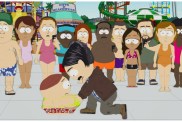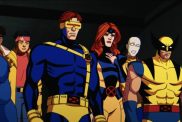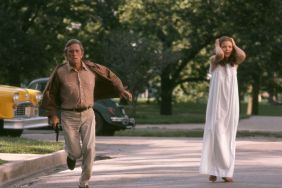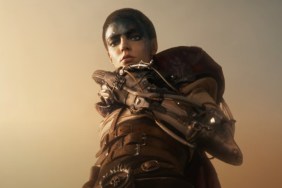
It’s because of movies like Mad Max: Fury Road that movie theaters were invented. This is sheer spectacle at its best as George Miller revisits a character he first brought to life on the big screen in 1979 and last visited 30 years ago. With the help of Tom Hardy and Charlize Theron, and some of the most face-melting practical effects and stunts you’ll see on the big screen this year or any year, Miller has crafted a big budget feature with narrative oomph and visual “WOW!”
You don’t need to have seen or even be aware of Miller’s previous Mad Max films to dive headlong into Fury Road. An attempt is made to give newcomers to the franchise some idea of what has come to pass with Hardy, as the titular Max, providing an opening voice over amid images of apocalyptic death and destruction. However, the burnt orange, scorched landscape is enough to tell us this isn’t a place any of us ever want to call “home” as Max stomps a two-headed lizard, eats it and jumps in his signature Interceptor as a horde of psychopaths are quickly seen chasing him down.
Fury Road moves at this pace for pretty much the duration of its two-hour entirety, never really stopping to tell its story, but instead opting to offer plot details while ripping through the dusty future while the grit of sand sticks between your teeth and explosions tear through the silver screen. What’s amazing is among all this madness, Fury Road does have a story, or at least enough of one to give just enough weight to the action that it doesn’t seem like you’re watching a standard, modern day studio blockbuster merely interested in mindless movement than actually getting us from A to Z with narrative stops along the way.
Despite its title, Mad Max: Fury Road is less about its title character and more about Theron’s commanding performance as Imperator Furiosa and her escape from the clutches of the tyrannical Immortan Joe (Hugh Keays-Byrne whom many will know as Toecutter from the first Mad Max). Lording over a towering cliffside community known as the Citadel, Joe controls the water he pumps out of the Earth, the crops his slaves tend to and the women he keeps captive to either a.) provide him offspring or b.) provide the society’s top percent breast milk for consumption while the rest of society is left to literally look up from below, begging for scraps as their skin is torched and their teeth fall out.
From this community Furiosa, held captive since she was a child, escapes Joe’s clutches with his “five wives” (the women he holds captive for the purposes of bearing him children) as she turns a normal run for fuel into a scramble across the Wasteland in a massive War Rig. It’s here her fate is eventually intertwined with Max, who’s been captured for the purpose of milking his blood into the pale-faced “war boys” at Joe’s disposal, a group of men upon which Joe has instilled a martyrdom belief system, believing glory will be found beyond the gates of Valhalla at the time of their death in servitude of Joe and the Citadel.
Once together, Max and Furiosa must first decide whether or not to kill one another or work together, and even then, to what end? What does the Wasteland hold in store? What is there to find? Is escape even possible? Within the small narrative nuggets Miller offers there are a variety of cultural and societal themes you can dig out, or, if you’d rather just sit back and watch as the spectacular carnage unfolds, that is just as well.
Miller has taken and turned what it means to be a post-apocalyptic story on its head. He doesn’t desaturate the picture until it’s nearly black-and-white, but instead cranks up the contrast to the point the daytime is a searing orange and the nighttime is a cold, blistering blue. Against this he sets the stage with Colin Gibson‘s detailed production design, Jenny Beavan‘s costuming and practical effects that can only best be experienced on the largest screen possible.
The score from Junkie XL does become a bit burdensome at times, attempting to draw attention to itself and overshadow the action, but its rock-and-roll moments (such as Miller’s idea of a live guitarist serving as a fire-breathing post-apocalyptic radio) are a welcome bit of absurdity you can both recognize as ridiculous and awesome all at the same time.
Performances from Hardy and Theron standout, if only because Hardy is given very little to say while Theron pulls most of the narrative and emotional weight. Nicholas Hoult plays Nux, a young “war boy” whose system of belief is challenged as he seeks the approval of Immortan Joe in battle and Rosie Huntington-Whiteley (Transformers: Dark of the Moon) is the only one of the five wives really given much to do other than exist as a symbol of ill treatment and the need to escape, but her value to this film can’t be understated.
As such, Fury Road is as intensely insane as the marketing promised while at the same time offering enough story to hold it all together. Once you see a movie like Mad Max: Fury Road you begin to understand how tiresome other studio blockbusters have become. This isn’t a film that depends on CGI to build its world and it doesn’t depend on an action sequence to merely be “big” to entertain. The action here is based on both entertaining and storytelling, creating a nervy tension few studio blockbusters have even come close to achieving in the last several years. If you though the Fast and Furious films delivered when it comes to vehicular mayhem, just you wait. This is a film I’ll be watching at home for years to come, but am so, so, so happy I saw it first on the big screen, where it must first be seen to be truly appreciated.









